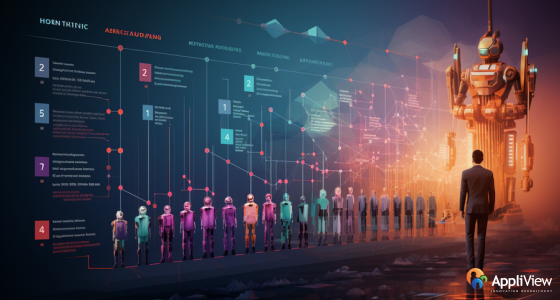From Job Listings to AI-driven Matches: The Future is Here!
September 18, 2023

AI-driven employment matching is revolutionizing the hiring process by identifying candidates with the right skills, experiences, and cultural compatibility. This technology streamlines the process, saving time and resources while making better hiring decisions. The essential elements of AI-driven job matching include qualifications, experience-based matching, and cultural compatibility. Technologies like Machine Learning, Natural Language Processing, and Big Data contribute to its success. Benefits of AI-driven job matching include faster hiring, improved candidate quality, reduced bias, and cost savings. However, privacy and ethical concerns must be addressed. Case studies show the ROI and practical benefits of AI-driven hiring solutions. Businesses should choose the optimal AI-driven solution based on scalability, tailorability, and support. The AI-driven future of recruiting is here, and businesses can transform their hiring processes to save time, cut costs, and create more productive teams.
From Job Listings to AI-driven Matches: The Future is Here!
Finding the right talent for your business in today’s rapidly changing labor market can be a daunting endeavor. Large and medium-sized businesses, as well as startups, are always looking for methods to streamline their hiring processes, reduce costs, and, most importantly, identify candidates who not only possess the required skills and experience but also align with their company culture. Traditional methods of sifting through countless job applications have proved to be time-consuming and frequently lead to hiring decisions based on insufficient data. However, there was a method to avoid this situation. Introduce AI-powered employment matching.
The Importance of Intelligent Job Matching
The success of a business depends on its ability to recruit the best candidates. However, the standard recruiting procedure is fraught with obstacles. Reviewing resumes, conducting interviews, and determining cultural compatibility can be tedious and subjective. Additionally, it is difficult to make decisions based on data when you are inundated with job applications. Here, AI-powered task matching comes into play.
AI-driven job matching employs artificial intelligence to intelligently match candidates to employment positions based on a variety of criteria, such as skills, experiences, and cultural compatibility. By automating and improving the recruiting process, businesses can save time and resources while making better hiring decisions.
The Essential Elements of AI-driven Job Matching
Fundamental to AI-driven employment matching is matching based on qualifications. This requires analyzing a candidate’s skills and qualifications and comparing them to a job’s requirements. AI algorithms assess the relevance and proficiency of each skill, ensuring that candidates are well-suited for the positions they’re being considered for.
Experience-based matching takes a candidate’s employment history and prior experiences into account. AI examines a candidate’s previous duties, responsibilities, and accomplishments to determine how well they match the job’s requirements. This enables employers to rapidly identify candidates with relevant experience.
Technologies Powering Artificial Intelligence-driven Job Matching
Several essential technologies contribute to the success of AI-based job matching:
- Learning Machine (ML) : Algorithms utilizing machine learning analyze immense amounts of data to identify patterns and make predictions. In the context of hiring, ML can predict which candidates are most likely to perform in specific roles based on historical hiring data.
- Natural Language Processing (NLP) :Natural Language Processing enables AI systems to comprehend and process human language. It is essential for deciphering and analyzing job applicants’ resumes, cover letters, and other textual data.
- Big Data and Analytical Methods : Massive datasets of job listings, candidate profiles, and historical hiring data are required for AI-driven job matching. Big data technologies allow for the effective storage and analysis of this data.

Employer Benefits of AI-driven Job Matching
Implementing AI-driven employment matching can provide businesses with numerous benefits:
AI can evaluate and match job applications in a fraction of the time it would take a human, thereby speeding up the hiring process.
- Improved Candidate Quality : By matching candidates based on their talents, experience, and cultural compatibility, AI identifies those who are more likely to excel in their roles.
- Reduced Bias : AI algorithms can make unbiased recruiting decisions, reducing the influence of unconscious biases that can affect human hiring managers.
- Cost Savings : Streamlining the recruiting process saves both time and money, making AI-driven job matching a cost-effective solution.

True-life Success Stories
Numerous businesses have already reaped the benefits of AI-driven job matching. Case studies illustrate how organizations have enhanced their recruiting processes, decreased time-to-fill positions, and improved the quality of hires. These success tales demonstrate the ROI and practical benefits of implementing AI-driven hiring solutions at the international level.
Choosing the Appropriate Technology for Your Organization
It is crucial to select the optimal AI-driven employment matching solution. Businesses should consider the scalability of the technology, the ability to tailor algorithms to their specific requirements, and the level of support offered by technology providers. Comparing various alternatives and posing pertinent queries can aid businesses in making informed decisions.
The conclusion
The AI-driven future of recruiting has arrived. Businesses can transform their hiring processes by employing AI to intelligently match candidates to jobs based on talents, experiences, and cultural compatibility. They can save time, cut costs, and make better-informed decisions, resulting in ultimately stronger and more productive teams.
